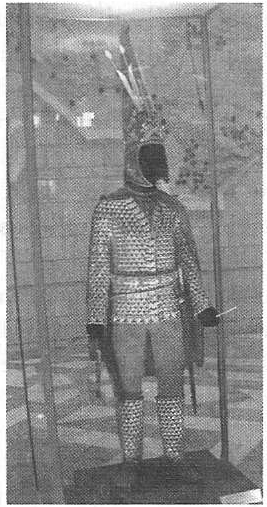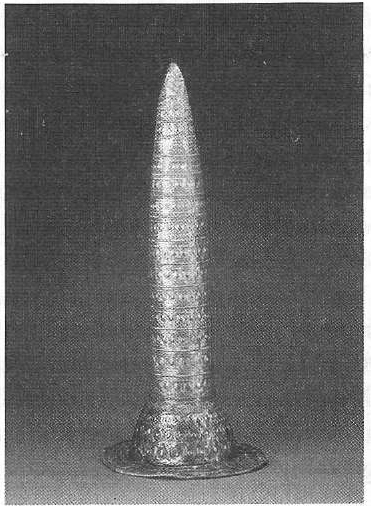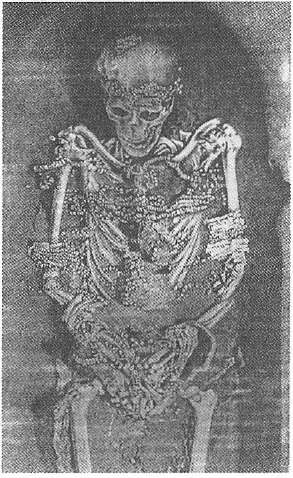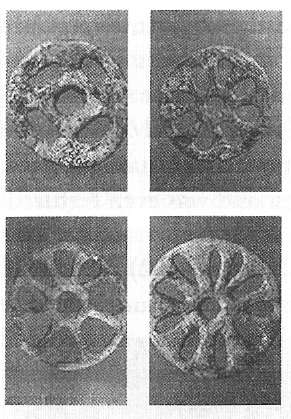II. The traces of Magi in the Carpathian Basin
in the millennia B.C.
The Carpathian Basin is the birth-place of the Linear Band Ceramics
Based upon the newest archaeological finds and the immense, connected system of scientific proofs, a brand new picture emerges in front of our eyes concerning the origin of the culture of ancient Europe, the Carpathian Basin, Mesopotamia, China, India and America, which differs greatly from that based upon the information implanted into the public consciousness. From the pen of T. Douglas Price and his colleagues (Price et al, 2001), a work of basic importance has emerged in the pages of the influential archaeological periodical called "Antiquity". Here the authors demonstrated, with the newest research method, with strontium isotopes (isotope: the same chemical element with a slightly different atom-weight variation) that the first great culture of pre-historic Europe, the Linear Band Ceramic culture started out from the territory of present day Hungary around 5700 B.C., and not only was the culture transmitted, but it was spread far and wide by scholars with great knowledge. The majority of the wandering scholars were young women of great knowledge.
This fact refers to the matriarchal society of the Carpathian Basin of that age, and also the presence of an extremely advanced culture. Persons with an outstanding level of knowledge were called Magi in prehistoric and ancient times. So, if there were women with advanced knowledge in the Carpathian Basin at that time, then the European center of the Magi was here. The culture of the Linear Band Ceramics, for example, reached the Rhine around 5,500 B.C. (Price et al., 2001).
Seven thousand years ago, these Magi built the first Sun temples in the Carpathian Basin, the first temples in Central Asia, and the stone-circles all over the world. These Magi carried mankind's ancient knowledge, which goes back to the era of man's evolution, millions of years ago. (Leakey-Lewin, 1986, 235; GKE-GA, 2006, 104-110; GA, 2006, 19-31). Price and his colleagues (2001) write that Europe can thank the people of the Linear Band Ceramics for, among others, the sciences of agriculture, architecture, burials, refined pottery and high quality stonework.
As we have seen in the introduction, these facts are characteristic of the activities of the Magi and culture-heroes. Most researchers place the culture of Linear Band Ceramics to the Starcevo-Körös Culture, in the territory of today's Northern Serbia and Hungary. According to Haak and colleagues (2005), the source of origin of the Linear Band Ceramics and the linear decorated pottery of the Hungarian Lowlands (Alföld) is today's Hungary and Slovakia. Considering that Slovakia and Northern Serbia[11] did not exist in the 6th millennium B.C., we find the term Carpathian Basin to be more accurate and true to the age. Many researchers consider the culture of Linear Band Ceramics to be the creation of the indigenous population of the Carpathian basin (Linear Pottery Culture, 2006).
The continuity of the people of the Linear Band Ceramics in the Carpathian Basin was essentially unbroken. The first arrow-making people lived here at least from 34,000 B.C. and, in the first millennium A.D., the Hun-Magyar people, who lived here, were still outstanding archers. From 33,000 B.C. to today these people have also been masters of the art of animal representation, and the tongue-duct flute (GKE-GA, 2006, 228), and they were the people of the Magi from the vast ages of the ancient past to the second millennium B.C. (Ibid. 78-103; 177-184). This continuity is shown by the Scythian cone-shaped head-gear, which represents the sun-rays, emerging in a cone-like manner from the Sun (Singh, 1993, 74) beginning in the 6th millennium B.C. to present-day Hungary.
Following the culture of the Linear Band Ceramics (Keys, 2005), Europe's first church-building people started out from the Carpathian Basin, in the 6th millennium B.C., followed by the people of the scepter in the 6-3 millennium B.C. (Govedarica, 2004, see below), and the Cucuteni-Tripolje Culture, which is contemporary with the Scythians (5,500-2,400 B.C.; GKE-GA 2006, 20-23). Then came the builders of Stonehenge, who are called the Bell Beaker people, named after the Scythian cultic drinking vessels (Price et al., 2004), or the bell-shaped drinking vessels, who were buried with royal scepters during the time period of 3,100-1,600 B.C. (GKE-GA, 2006, 25-28), or between 2,800-1,900 B.C.; the people, who built stone circles, similar to Stonehenge and later known as Scythian stone circles, from 4,800 B.C. to 500 A.D., who lived in the Carpathian Basin, and the Central European Royal Magi, who wore the characteristic pointed head-gear of the Scythian Magyars lived there too, in the 2-1 millennium B.C. (Menghin, 2003; Paterson, 2002; GKE-GA 2006, 31-39).

Picture 4. Saka, or Central Asian Scythian (or Magyar) warrior's attire from 2,500 years ago, from the Issik kurgan on the shores of the Kul Lake.

Picture 5. The "golden cone-cap of Berlin" from the 1 0 - 8 c. B.C., which was found on the border of Southern Germany and Switzerland. It is the characteristic head-gear of the Royal Magi. Museum fürVor- und Früh-geschichte, Schloss Charlottenburg, Berlin
Methodological remarks concerning the establishment of the
Magyar-Hun-Scythian cultures chronology
In recent centuries, it has become customary, in the western and the official Hungarian historiography, to squeeze the culture that the Greeks called "Scythian" into a time frame of a few centuries. Today, this most often means the 8—5 centuries B.C. (Kemenczei, 2002, 67). This has partly methodological reasons. Modern archaeology makes judgments according to the characteristic features of the excavated objects. With the advancement of technology, new materials and methods emerge in the formation of materials, in the discovery of new fashions and new characteristics. Based upon these methods, the unified culture of the same people can also be fragmented. For example the Hungarian people, proceeding backwards in time, may be called the people of computers, a few decades earlier the people of television, even before that, the people of radio, and so on. In reality the cultures used to be divided in a similar manner. In broad strokes, such divisions are, for example, the pre-historic times, ancient times, the newer age, the even newer age and within the very newest age, even smaller time-fragments are frequent. We would like to emphasize that this methodological conditioning should not dim the true folk, historical and cultural unity which is behind the different material characteristics and fashions. It is obvious that the culture of the Carpathian Basin, at least in the last one thousand years, has shown a basic continuity, and moreover, the main question in the study of the Magyar ancient history is: on what is this basic cultural continuity based and how far can it be extended?
Kornél Bakay presents the most important characteristics of the Scythian-Saka culture as follows:
- the kurgan burials;[12]
- the burial of wagons;
- animal husbandry;
- lost-wax-casting; metallurgy of high quality;
- primary use of iron;
- animal representations in art;
- stag-cult;
- Sun god belief and Sun sanctuaries;
- burial masks;
- Europid anthropological type;
- custom of blood-covenant;
- cavalry with heavy armor;
- reflex-bow;
- construction of international roads of commerce and their use;
- sword-cult;
- burial of carpets and textiles;
- ritual vessels: cups, mirrors, drinking horns, cauldrons (Bakay, 2005,42.).
It is worth noting that certain characteristics mark separate, different time-frames too. The kurgan burial can already be shown from the 5th millennium B.C. (Kurgan Hypothesis, 2007). The Europid characteristics and the art of animal representation are at least 40-45,000 years old (Poikalainen, 2001). The high quality of metallurgy can be noted also from the fifth millennium B.C. (Kalicz és Raczky, 2002, 40.); on the other hand, the Iron Age began only in the 8th century B.C. (Kemenczei, 2002, 67.).
It is clear that the characteristics enumerated by Bakay are really correct but it is also clear that not all of them can be considered basic characteristics, which at the end assure unity. Man cannot be judged by his objects alone. The material view is limiting, due to its inherent nature and, for this reason, it may be misleading in the research of the continuity of a people. All people are basically spiritual and cultural entities, based upon the feeling of connection. Therefore, the material examination, which is limiting, has to be rounded out with the traces of spiritual cultures and their well founded organization.
The Magyars, who received the name "Scythian" from the Greeks, according to a whole line of ancient authors and also historical analyses (GKE, 1996 a, b, c), are Mankind's ancient people. With all certainty, this ancestral people did not use the name Scythian, given to them by the ancient Greeks, in the millennia, or even millions of years prior to the ancient Greeks. The other name of the Huns in India was Magyar (Madzsar) (Czuczor-Fogarasi, 1867, 4: 56-57; 2: 1733-1738). Czuczor and Fogarasi, in their quoted work refer to the collection of "Abhandlungen fur die Kunde des Morgenlandes", Vol.1, no. 4 (Leipzig, 1858). According to the text found at the bottom of pages 41 and 42, the "mudgara" may have been the name the Indian White Huns called themselves. According to the Isfahan Codex, the Huns trace their origin back 28,000 years. (Detre, 2004, 2005). It is best to call a people by their own name. So, in harmony with the results obtained through the analysis of the Tarih-i Üngürüsz (GKE, 1979; 1990, 17, 40-43) - from now on, instead of the nation-name Scythian or Hun, we will use first of all the name of the Magyar nation. However, if this is not the best solution in a given context, then it is suggested that we keep to the 'Scythian' and 'Hun' nation names. The meaning of the name Hun: Majestic Royal people.
In Chinese sources, the name of the Huns before the 11th century B.C. was "Rong" or "Zhong". (The Chinese are unable to pronounce the "r" sound, and usually try to substitute it with the 'zh" or 'dj" sounds.) At the end of the Chou-Age (from 1028-221 B.C.) the name "Zhong" went out of fashion and was exchanged for the name "Hsiungnu" (FitzGerald, 1989, 156.). 110 volumes of Sima Qian's 130 volume work deal with the earliest history of the Huns. The ancestor of the Xiongnu, the descendant of the Xia imperial house, was Chun-hui.
Even before the time of emperors Yao and Shun (in other words before the third millennium B.C; Huang Di, Yao and Shun constitute the three legendary wise men - G. A.) "there were Shanrong (mountain Rong), Xianyun and Xunyu people who lived in the northern wilderness and, following their animals, they wandered from one territory to the next." (Sima Qian, 1997, 17; de Groot and Bakay, 2006, 23-25.) According to tradition, Huang Di lived between 2698-2599 B.C. (Poon, 2006). Huang-ho, the main river of North China, the cradle of the Chinese civilization, received its name from the Hun people (Szász és Bakay, 1994, 25). Because "ho" means river, and Huang Ho bore the name of the Huns, the meaning of "Huang" must have been "Hun".
The same "Huang" word is present in the name of Huang Di too! The original meaning of the Chinese character "Di", the ![]() is "a superior/extraordinary being" (see Tarih-i-Üngürüsz, 1982, 41, 402. The extraordinary beings are ordinary, above average, noble and brave people.), God-King (Three Sovereigns and Five Emperors, 2007), a King representing a Kingship which originated in Heaven, The original meaning of the
is "a superior/extraordinary being" (see Tarih-i-Üngürüsz, 1982, 41, 402. The extraordinary beings are ordinary, above average, noble and brave people.), God-King (Three Sovereigns and Five Emperors, 2007), a King representing a Kingship which originated in Heaven, The original meaning of the ![]() sign is Magus. The form of the sign itself originally portrayed a Magus, with the holy cloak over his shoulders (Ibid.), referring probably to the Sun with a cloak called kacagány in Hungarian.[13] So the meaning of the name Huang Di is: Hun Magus, God-King Hun, Hun heavenly King. The other meaning of the word "Huang" is: sublime. With this, the meaning of Huang Di is: Sublime Magus. Therefore, the name "Huang" means at the same time "Hun", and "sublime". This hints at the meaning of the name "Hun", which meant "the sublime (people)", people of heavenly origin. Tradition holds that Huang Di was a morally perfect Wise-King, and because, in the 3rd millennium B.C. such wise men were also called Mag, Magus, then Huang Di was a Magus King, a Royal Magus.
sign is Magus. The form of the sign itself originally portrayed a Magus, with the holy cloak over his shoulders (Ibid.), referring probably to the Sun with a cloak called kacagány in Hungarian.[13] So the meaning of the name Huang Di is: Hun Magus, God-King Hun, Hun heavenly King. The other meaning of the word "Huang" is: sublime. With this, the meaning of Huang Di is: Sublime Magus. Therefore, the name "Huang" means at the same time "Hun", and "sublime". This hints at the meaning of the name "Hun", which meant "the sublime (people)", people of heavenly origin. Tradition holds that Huang Di was a morally perfect Wise-King, and because, in the 3rd millennium B.C. such wise men were also called Mag, Magus, then Huang Di was a Magus King, a Royal Magus.
The Chinese name to honor the Hun High-King was: tan-hu, or senyő. It can be pointed out that, if the meaning of tan-hu is high-king, and if the Hun High-King is the Son of Heaven, then the first syllable of Tan-Hu is the ancient Magyar "Ten", the second syllable of the Hungarian word for God, Isten. The second meaning of Tan-Hu was: Son of God (Czuczor-Fogarasi, 1867, 2:1733-1738). The second syllable of Tan-Hu, the "hu", may be the shortened form of the Hun nation-name (Szász and Bakay, 1994, 25). So the meaning of Tan-hu was: Heavenly Hun, Son of Heaven Hun. The Chinese form of the Magyar word senyő is xienyu; in other words, it is related to the name of the ancient Hun people, the Xu-anyun, Xuanyuan, Xunyu. Based upon this, the Xiungnu name of the Huns may have been the form closer to the Magyar spelling, the Tan-hu; in other words, the Hun nation name: the people of the Sons of Heaven. Hungarian tradition is in agreement; it states that the Magyars are the Sons of the Sun. (GKE, 1996d, 42,1996e, 13; GA, 2006,181,199).
The Chinese pronounce the 'x' the same as the Magyar 's' (sh in English). Therefore, the Xianyun and Xunyu Hun people's name was "sanyo, sunyu", (pron. shanyo, shunyu) and if this "sanyo, sunyu" is related to the concept of the Hun "senyő", which meant "High-King", then the meaning of the Chinese name "xia-nyun, xu-nyu" for the ancient Hun people is: royal people.
However, we should be careful. Let us forget for a moment the "Hun" meaning of the word "Huang", and let us take into consideration the "majestic" meaning instead. In this case the meaning of Huang Di's name is "Majestic King of Heavenly Origin". This explanation leads us to the Huns! Namely, the full name of the High Kings is T'ing-li (Heaven) ko-to (son) tan-hu (the title of the Hun High King), in other words "Son of Heaven High King" (Szász-Bakay, 1994, 26.). The"Majestic King of Heavenly Origin" is in another form "Son of Heaven Majestic King", or "Son of Heaven King of Kings", which is "Son of Heaven High King" or Hun High King. This explanation leads us to the deduction, that the meaning of Huang Di's name corresponds with the full title of the Hun High-Kings, in other words it may have been Huang Di Hun High King.
The meaning of the name of the Hun nation as "royal people" is supported by the fact that the Xia Dynasty was of Hun origin, and this Hun dynasty gave China her first kings. History has recorded only one royal people: the Royal Scythians. The Hun High King was the King of 13 different kings, or the King of many kings and all these royal titles are of Hun origin (Szász-Bakay, 1994, 26-27). This basic fact undoubtedly indicates that the institution of royalty was the most complete among the Huns, the most comprehensive, and it was born of Hun thought.
Because the Xia was a Hun nation, the first meaning is: Hun. The second meaning in the Chinese language is: great - in Sanscrit: mah, related to the Magyar mag meaning seed (see above). While examining the ancient meaning of the Magyar word Magus we referred to the fact, that "great" and "mag" are in close relationship, so the Xia nation-name originally may also have meant Mag. The name of the Chinese people, beginning in the age of Huang Di, through the following three thousand years, was Huaxia and it is still often used, although the Huaxia people were officially called the Han people from the Han Dynasty on. The meaning of hua is: spectacular, brilliant, splendid, magnificent and resplendent. If this is so, then the first meaning of the Huaxia people is: Resplendent Hun People. The second meaning is: Resplendent, Great People. The third meaning is: The Resplendent Mag people. In this third case, the meaning of the Huaxia nation is: The People of the Resplendent Magi.
The word Hua today is almost synonymous with Chinese. The Chinese People's Republic, that is, the official name of the Chinese republic today, is Zhonghua. The"Zhong" is the ancient name of the Huns in China, so the meaning of the Chinese Republic's official name is: The Country of the resplendent Huns. The name of the "business class" on the airplanes of the Chinese Airlines is: Huaxia Class (Yang, An and Turner, 2005,138-145). In other words the name of an outstanding, noble, very rich class is: The Class of the Resplendent Huns.
The people of the Royal Scepter Bearers
The monograph of Blagoja Govedarica, Professor of Archaeology at the University of Hamburg, was published in 2004 (Govedarica, 2004) under the title Zeptertrager - Herrscher der Steppen, with 436 pages, 56 illustrations and 8 photographs. The meaning of the scepter is: royal ruling wand. In other words, we are dealing again with a royal people. The archaeological excavations, described by Govedarica point to the fact that the culture of these people, with royal symbols, started out from Transylvania around 5,100 B.C. The contracted, fetal position of the skeleton corresponds to the burial custom of Polgár-Csőszhalom, Hungary in 4,800 B.C. Five cultural centers, with several thousand kilometers between them, kept close ties with one another for more than three-thousand years: the Carpathian Basin, the Delta of the River Danube, Etelköz, the Volga-Caspian district and Northern Caucasus. At the beginning, the scepters were made of stone and at the top frequently a horse-head or some other animal head is visible. The main characteristic of the scepter-bearing people is the use of the Royal Scepter. A people that consists of kings! It is astonishing, but we cannot say anything else based upon the archeological evidence.
28,000 year-old royal find in Sungir
Not long ago, the Sungir find, which was excavated a hundred kilometers north of Moscow and is from the 23-30 millennium B.C., aroused world-wide interest and was even featured on the cover of the Scientific American in 2001 (Tattersall, 2001),

Picture 6. The find of Sungir.
The Sungir find can be connected to the Uralic people (Szabó, 2004, 60-62). The most significant representative of the Uralic language family is Hungarian. We can judge the extraordinary richness of the Sungir find, by the fact that, in the Western-European Bronze Age, which lasted 900 years, a grave which contained more than five valuable objects was considered to be rich (Young, 2002), and only one was found that contained more than one hundred valuable objects, (Stonehenge's Archer-King's grave from about 2300 B.C.), and this richness also came from Central Europe, from the Carpathian Basin (see Keys, 2005; Milmo, 2005). In comparison, the Sungir find is considered to be true royal richness and is the more remarkable because it is from a much earlier period.
On the Sungir man, 2,936 pearls of finely worked mammoth ivory were found. Most of these were strung on threads, forming a head-band around the forehead. It seems that, apart from the head-band, one of the cross-bands of a crown, - which is similar in structure to the Hungarian Holy Crown - remained relatively intact; the other remained only in traces. Beside him was an almost 20 kilogram heavy, mammoth tusk, softened and straightened, almost two and a half meters long. It may have been the staff of a leader, in other words a royal scepter. The straightening of the mammoth tusk required an advanced technology and scientists have not yet discovered what chemical methods were used to do this. It could not have been a hunting weapon (lance), because it was too heavy for this (Rudgley, 2002, 220.). This supports the supposition that it was a ceremonial sign of a dignitary, a royal scepter. The mammoth-bone Sun disks from the grave are divided into eight parts between the outer and the inner circle.
It is very remarkable that these 28,000 year-old inner and outer circles connected with spokes are almost completely identical to the Sun-disks upon the golden conical hats of the Magi in the 2nd-1st millennium B.C., where the space between the inner and outer rings is divided into eight (see picture on the next page)!

Picture 7. ivory Sun-disks from the Sungir grave.

Picture 8. Sun-disks of the golden conical hats of the Magi in the 2nd to 1st millennium B.C.
Buddha, who was of Scythian origin, and whose name is pronounced in his homeland, India, similarly to the Hungarian "Buda" was born from a lotus with eight-petals. In symbolic language this means that Buda is the Son of the Sun. In the Egyptian "Book of the Dead", the Goddess of Heaven, Hathor, wears the same sun-disk with eight petals on her neck. The remains of the clothing in the grave bears witness to an advanced textile-culture. Since the Uralic people were the ancestors of the Hungarian, Ukrainian, Polish and Croatian people, (Szabó, 2004, 60), whose language has been preserved until today only by the Hungarians, the statement that the Magyar Kingship can look back to a more than a 20,000 year-old past is archaeologically supported. Furthermore, if we try to find connections between the sun-disks, the extraordinary richness and high level of culture, the royal scepter and the royal crown-like head-decoration, we can explain everything with one factor: the King of Sungir was a Sun-King.


Hozzászólás
i was searching about magi people and where they are present in other parts of world then i came through your website and i came to know after reading some articles that my grandpa was right and i was also surprised that he never used internet but even though he knew that our people are in europe which i found on your website. but in india we are in very less population. i would like to know and share more.
thankyou.
Much thanks in advance
osszes munkai,a legmagasabb,tortenelmileg alatamasztott szinten allnak,ezt csak elfogadni kell,
minden igaz Magyarnak.